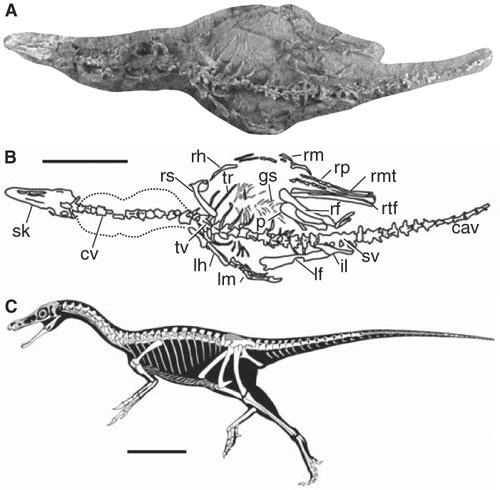The presence of the basal avialan Archaeopteryx in the latest Late Jurassic (Tithonian) and the poor fossil representation of more basal maniraptoran taxa in contemporaneous or slightly older deposits indicate either a gap in the stratigraphic record or, more controversially, that birds are not related to theropods. Recent discoveries of Middle-Late Jurassic maniraptorans from China are starting to fill in the temporal gap, but the ages of these new taxa are poorly resolved, and they do not clarify basal maniraptoran diversification because very little character evidence separates them from birds.
 |
|
Haplocheirus sollers (IVPP V15988). (A) Photograph of holotype in dorsal view. (B) Line drawing of holotype in dorsal view. Dashed line indicates crocodyliform fossil underlying cervical vertebrae. (C) Reconstruction. Gray fill indicates portions of the skeleton that are not preserved. |
Dr. XU Xing, Institute of Vertebrate Paleontology and Paleoanthropology, Chinese Academy of Sciences, and his collaborators, recently describe a three-dimensionally preserved, nearly complete skeleton of an alvarezsauroid theropod, Haplocheirus sollers, gen. et spec. nov., from orange mudstone beds in the upper part of the Shishugou Formation in Wucaiwan area, Junggar Basin, Xinjiang, China.
Radiometric dating constrains the age of this fossil to between 158.7 T 0.3 and 161.2 T 0.2 Ma (million years ago), corresponding to the Oxfordian marine stage in the early Late Jurassic . The dates for Haplocheirusreduce the conflict between the fossil record and phylogenetic hypotheses that early maniraptoran diversification took place in the Jurassic. Alvarezsauroids are known from South America , Asia, North America, and Europe. The basal phylogenetic position and early temporal position of Haplocheirus imply that Alvarezsauroidea originated in Asia rather than South America.
Derived members of the Alvarezsauroidea were originally thought to be flightless basal avialans because they share many morphological characteristics with birds, including a loosely sutured skull, a keeled sternum, fused wrist elements, and a posteriorly directed pubis. Haplocheirus preserves plesiomorphic morphological characteristics that confirm a basal position for Alvarezsauroidea within Maniraptora, demonstrating that these features of derived alvarezsauroids represent dramatic convergences with birds.
The original paper was published in SCIENCE VOL 327, 29 JANUARY 2010.
Related News
Photos
More>>trade
- Exceptional Dinosaur Fossils Show Ontogenetic Development of Early Feathers
- CAS Launches High-Performance Distributed GPU Supercomputing System
- U.S., Russian Scientists Cooperate with Scientists of IHB on Research of Yangtze
- CAS Sends Rescue Team to the Earthquake-Stricken Yushu County
- CEODE Obtained First Batch High-resolution Airborne Remote Sensing Data of Yushu





